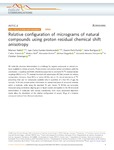Relative Configuration of Micrograms of Natural Compounds Using Proton Residual Chemical Shift Anisotropy

Ver/
Use este enlace para citar
http://hdl.handle.net/2183/26329
A non ser que se indique outra cousa, a licenza do ítem descríbese como Atribución 4.0 Internacional
Coleccións
- GI- Quimolmat - Artigos [104]
Metadatos
Mostrar o rexistro completo do ítemTítulo
Relative Configuration of Micrograms of Natural Compounds Using Proton Residual Chemical Shift AnisotropyAutor(es)
Data
2020-09-01Cita bibliográfica
Nath, N., Fuentes-Monteverde, J.C., Pech-Puch, D. et al. Relative configuration of micrograms of natural compounds using proton residual chemical shift anisotropy. Nat Commun 11, 4372 (2020). https://doi.org/10.1038/s41467-020-18093-5
Resumo
[Abstract] 3D molecular structure determination is a challenge for organic compounds or natural products available in minute amounts. Proton/proton and proton/carbon correlations yield the constitution. J couplings and NOEs oftentimes supported by one-bond 1H,13C residual dipolar couplings (RDCs) or by 13C residual chemical shift anisotropies (RCSAs) provide the relative configuration. However, these RDCs or carbon RCSAs rely on 1% natural abundance of 13C preventing their use for compounds available only in quantities of a few 10’s of µgs. By contrast, 1H RCSAs provide similar information on spatial orientation of structural moieties within a molecule, while using the abundant 1H spin. Herein, 1H RCSAs are accurately measured using constrained aligning gels or liquid crystals and applied to the 3D structural determination of molecules with varying complexities. Even more, deuterated alignment media allow the elucidation of the relative configuration of around 35 µg of a briarane compound isolated from Briareum asbestinum.
Palabras chave
NMR
Structure elucidation
RCSA
Stereochemistry
Briarane
Structure elucidation
RCSA
Stereochemistry
Briarane
Versión do editor
Dereitos
Atribución 4.0 Internacional
ISSN
2041-1723






